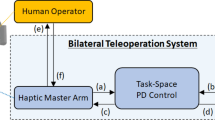Abstract
Tele-rehabilitation provides remote physiotherapy services for patients who have limited access to hospitals. This paper proposes a sensorless tele-rehabilitation system for the upper-limb using two robots in master–slave configuration. The system provides a transparent haptic feeling between the therapist and the patient by simultaneous tracking of both position and torque. The torque is measured using the reaction torque observer. Furthermore, an online recursive numerical parameter estimation method is proposed to identify the gravity disturbance in bilateral teleoperation. The system automatically estimates the parameters using the reaction torque observer output’s data while the therapist is delivering remote physiotherapy services. The estimated gravity torque is compensated in the system as an improvement of the transparency of the teleoperated system. Therefore the therapist would feel only the abnormalities of the patient’s arm. Estimated parameters automatically update the system and enhance the performance. The proposed method was practically verified with a master slave tele-rehabilitation system. Results suggest the applicability of the proposed method.












Similar content being viewed by others
References
Plautz EJ, Milliken GW, Nudo RJ (2000) Effects of repetitive motor training on movement representations in adult squirrel monkeys: role of use versus learning. Neurobiol Learn Mem 74(1):27
Stucki G, Stier-Jarmer M, Grill E, Melvin J (2005) Rationale and principles of early rehabilitation care after an acute injury or illness. Disabil Rehabil 27(7–8):353
Babaiasl M, Mahdioun SH, Jaryani P, Yazdani M (2016) A review of technological and clinical aspects of robot-aided rehabilitation of upper-extremity after stroke. Disabil Rehabil Assist Technol 11(4):263
Prange GB, Jannink MJ, Groothuis-Oudshoorn CG, Hermens HJ, IJzerman MJ (2006) Systematic review of the effect of robot-aided therapy on recovery of the hemiparetic arm after stroke. J Rehabil Res Dev 43(2):171
Volpe B, Krebs H, Hogan N, Edelstein L, Diels C, Aisen M (2000) A novel approach to stroke rehabilitation robot-aided sensorimotor stimulation. Neurology 54(10):1938
Cherry CO, Chumbler NR, Richards K, Huff A, Wu D, Tilghman LM, Butler A (2017) Expanding stroke telerehabilitation services to rural veterans: a qualitative study on patient experiences using the robotic stroke therapy delivery and monitoring system program. Disabil Rehabil Assist Technol 12(1):21
Zhang S, Guo S, Gao B, Hirata H, Ishihara H (2015) Design of a novel telerehabilitation system with a force-sensing mechanism. Sensors 15(5):11511
Park HS, Peng Q, Zhang LQ (2008) A portable telerehabilitation system for remote evaluations of impaired elbows in neurological disorders. IEEE Trans Neural Syst Rehabil Eng 16(3):245
Song A, Wu C, Ni D, Li H, Qin H (2016) One-therapist to three-patient telerehabilitation robot system for the upper limb after stroke. Int J Soc Robot 8(2):319
Song A, Pan L, Xu G, Li H (2015) Adaptive motion control of arm rehabilitation robot based on impedance identification. Robotica 33(9):1795
Just F, Özen Ö, Tortora S, Riener R, Rauter G (2017) Feedforward model based arm weight compensation with the rehabilitation robot ARMin. In: Rehabilitation robotics (ICORR), 2017 international conference on, IEEE, pp 72–77
Moubarak S, Pham MT, Moreau R, Redarce T (2010) Gravity compensation of an upper extremity exoskeleton. In: Engineering in medicine and biology society (EMBC), 2010 annual international conference of the IEEE, IEEE, pp 4489–4493
Ugurlu B, Nishimura M, Hyodo K, Kawanishi M, Narikiyo T (2015) Proof of concept for robot-aided upper limb rehabilitation using disturbance observers. IEEE Trans Hum Mach Syst 45(1):110
Abeykoon AHS, Ruwanthika RM (2016) Remote gripping for effective bilateral teleoperation. In: Handbook of research on human–computer interfaces, developments, and applications, IGI Global, pp 99–134
Takei T, Shimono T, Kubo R, Nishi H, Ohnishi K (2008) Gravity compensation for improvement of operationarity in bilateral teleoperation. IEEJ Trans Ind Appl 128(6):767–774
Nishimura K, Ohnishi K (2006) Gravity estimation and compensation of grasped object for bilateral teleoperation. In: Advanced motion control, 2006. 9th IEEE international workshop on, IEEE, pp 72–77
El Kalam AA, Ferreira A, Kratz F (2016) Bilateral teleoperation system using QoS and secure communication networks for telemedicine applications. IEEE Syst J 10(2):709
Just F, Baur K, Riener R, Klamroth-Marganska V, Rauter G (2016) Online adaptive compensation of the ARMin Rehabilitation Robot. In: Biomedical robotics and biomechatronics (BioRob), 2016 6th IEEE international conference on, IEEE, pp 747–752
Katsura S, Matsumoto Y, Ohnishi K (2007) Modeling of force sensing and validation of disturbance observer for force control. IEEE Trans Ind Electron 54(1):530
Mizuochi M, Tsuji T, Ohnishi K (2006) Improvement of disturbance suppression based on disturbance observer. In: 9th IEEE international workshop on advanced motion control, 2006, IEEE, pp 229–234
Perera GA, Pillai MB, Harsha A, Abeykoon S (2014) DC motor inertia estimation for robust bilateral control. In: Information and automation for sustainability (ICIAfS), 2014 7th international conference on, IEEE, pp 1–7
Ohnishi K, Matsui N, Hori Y (1994) Estimation, identification, and sensorless control in motion control system. Proc IEEE 82(8):1253
Chinthaka MD, Abeykoon AHS (2015) Friction compensation of DC motors for precise motion control using disturbance observer. ECTI Trans Comput Inf Technol (ECTI-CIT) 9(1):74
Ohnishi K, Shibata M, Murakami T (1996) Motion control for advanced mechatronics. IEEE/ASME Trans Mechatron 1(1):56
Author information
Authors and Affiliations
Corresponding author
Additional information
Publisher's Note
Springer Nature remains neutral with regard to jurisdictional claims in published maps and institutional affiliations.
Rights and permissions
About this article
Cite this article
Harischandra, P.A.D., Abeykoon, A.M.H.S. Upper-Limb Tele-Rehabilitation System with Force Sensorless Dynamic Gravity Compensation. Int J of Soc Robotics 11, 621–630 (2019). https://doi.org/10.1007/s12369-019-00522-1
Accepted:
Published:
Issue Date:
DOI: https://doi.org/10.1007/s12369-019-00522-1




